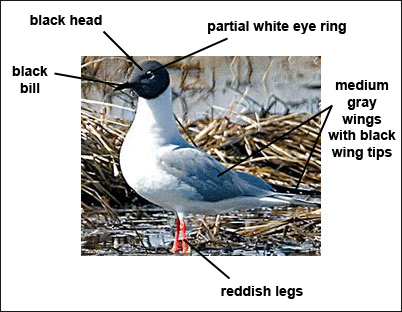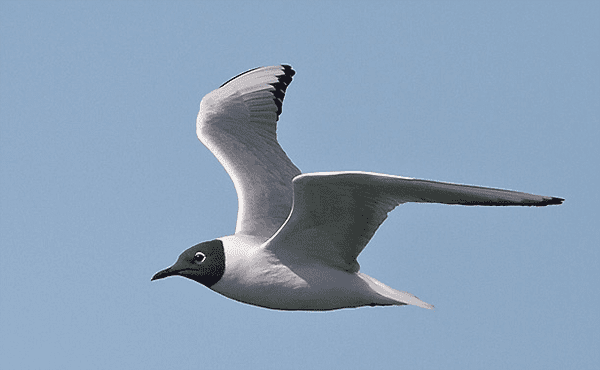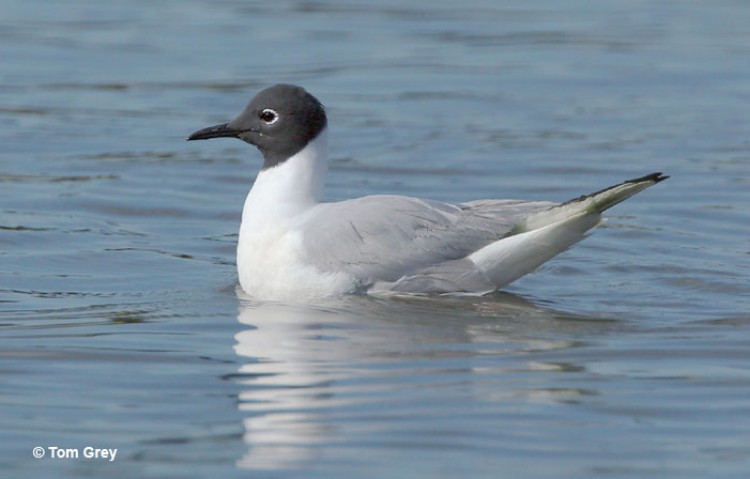The Bonaparte’s Gull nests in remote areas of Canada and Alaska, and is the only gull that nearly always nests in trees. Young Bonaparte’s Gulls jump out of the nest when only a week or less old, and in late July they begin migrating south shortly before the adults.
Bonaparte’s Gulls are quite small for a gull, and are very graceful in flight. If a predator or human approaches a nest, the adults will often dive-bomb the intruder while giving alarm calls that sometimes attract other bird species.
On this page
Description of the Bonaparte’s Gull
BREEDING MALE
The Bonaparte’s Gull is a small, tern-like gull with reddish legs, white underparts, a black head, a thin, pointed, black bill, and narrow wings with black-tipped, white primaries. Length: 13 in. Wingspan: 33 in.

Female
Sexes similar.
Seasonal change in appearance
Winter adults have a mostly white head with a black “ear” spot, and pinkish legs.
Juvenile
Immatures resemble winter adults but have browner upperparts.
Habitat
Bonaparte’s Gulls inhabit lakes, bogs, rivers, and lagoons.
Diet
Bonaparte’s Gulls primarily eat insects, fish, and crustaceans.

Photograph © Glenn Bartley.
Behavior
Bonaparte’s Gulls forage by plunging into the water from the air, by picking up surface food from the ground or while swimming, or by catching insects in mid-air.
Range
Bonaparte’s Gulls breed from Alaska south to southern Canada, and winter in the Great Lakes, Pacific and Atlantic Coasts, and south-central U.S., as well as points south. The population is probably stable.
More information:
Bent Life History
Visit the Bent Life History for extensive additional information on the Bonaparte’s Gull.
Fun Facts
The Bonaparte’s Gull is the smallest widely distributed gull in North America.
Unlike many other gulls, Bonaparte’s Gulls generally do not forage in landfills, though they do visit sewage ponds for the abundant insects.
Vocalizations
The typical call is a rough “grrr.”
Similar Species
Black-headed Gulls (rare in the U.S.) are larger and have mostly dark inner primaries.
Franklin’s Gull
Franklin’s Gulls have thicker, less pointed red bills.
Nesting
The Bonaparte’s Gull’s nest is a platform of sticks lined with moss and grass and placed in a coniferous tree.
Number: Usually 3.
Color: Olive or buffy with darker markings.
Incubation and fledging:
The young hatch at about 24 days, but their development is not well known.
Bent Life History of the Bonaparte’s Gull
Published by the Smithsonian Institution between the 1920s and the 1950s, the Bent life history series of monographs provide an often colorful description of the birds of North America. Arthur Cleveland Bent was the lead author for the series. The Bent series is a great resource and often includes quotes from early American Ornithologists, including Audubon, Townsend, Wilson, Sutton and many others.
Bent Life History for the Bonaparte’s Gull – the common name and sub-species reflect the nomenclature in use at the time the description was written.
LARUS PHILADELPHIA (Ord)
This widely distributed American species is found at some season of the year in nearly all parts of our continent. As it retires to the northern wooded regions of Canada to breed, it is familiar to most of us only as a migrant or a winter visitor, and few naturalists have studied it on its breeding grounds. During the first warm weather in April, when the shad and herring are beginning to run up our rivers, we begin to see the migrating flocks of this pretty little gull moving northward along our coasts or up the valleys of our great rivers in the interior. They proceed in a leisurely manner, drifting along in loose flocks, as if aimlessly wandering, stopping to dip down and occasionally pick some morsel of food from the surface of the water, chattering to each other in soft conversational notes, or coursing over the meadows and marshes to catch the first flying insects of spring. The black-headed adults make up the vanguard of the migrating hosts, followed later by the immature birds; flocks of young birds, however, often have one or two adults with them as leaders. Sir John Richardson (1851) says: This species arrives very early in the season, before the ground is denuded of snow, aad seeks its food in the first pools of water which form on the borders of Great Bear Lake, and wherein it finds multitudes of minute crustacean animals and larvae of insects.
Nesting: I have never succeeded in finding its breeding grounds and must quote from what scanty accounts of its nesting habits have been published. Mr. Roderick MacFarlane (1891) writes:
Thirty-seven nests are recorded as having been taken, with eggs in them, between 10th June and 10th July, in the wooded country in the neighborhood of Fort Anderson and on Lower Anderson River. They were all built on trees at various heights (from 4 to 15 and even 20 feet) from the ground, and, with one exception, which was composed of down and velvety leaves held together by some stringy turf, they were made of small sticks and twigs lined with hay and mosses, etc. The parents always fly about in close proximity to the nest, and scream vehemently when explorers, in the interests of science, are obliged to deprive them of their eggs or young, and not infrequently shoot one of them. They seldom lay more than three eggs.
The following account is published by Baird, Brewer, and Ridgway (1884): Mr. Kennicott found this gull nesting in the neighborhood of Fort Yukon, and describes the nest as being of about the size of that of Zenaidura carolinensia; but the cavity is rather deeper. It was placed on the side branch of a green spruce, several feet from the brink, and about 20 feet from the ground, near a lake. Mr. Kennicott saw several nests near this one, all alike and in similar positions, except that some were not over 10 feet from the ground, and were on smaller trees; but all were on spruce trees. One nest which he examined contained three young birds of a dirty yellowish color, thickly spotted with dark brown. He saw between 25 and ~0 gulls about that breeding place, but he found only a few of their nests. These birds were said by the Indians always to breed in similar situations.
This species apparently bred formerly as far south as Michigan and Wisconsin, in the region of the Great Lakes. Mr. W. H. Collins (1880) was told by hunters living at St. Clair Flats that Bonaparte’s gulls bred “in Baltimore Bay and the North Channel, and that they lay their eggs on old logs with no signs of a nest.” Kumlien and Hollister (1903) write:
In 1880 a few were said to breed on Chambers Island, Green Bay, and we saw on some small islands in Big Bay de Noquet, Michigan, a number of nests like pigeons’ nests on the flat branches of low coniferous trees that without question had been used by these birds.
Eggs: The Bonaparte’s gull lays from two to four eggs, ordinarily three, frequently only two, and rarely four. The eggs somewhat resemble those of the Franklin’s gull, but are considerably smaller. In shape they are ovate, pointed ovate, or pointed elongate ovate. The ground color varies from “buffy citrine” or “Dresden brown” to “dark olive buff” or “deep olive buff.” They are more or less evenly spotted or irregularly blotched, rarely scrawled, with various shades of brown, “brownish olive,” and “brownish drab,” too numerous and variable to be definitely named. The measurements of eggs, in various collections, average 49.5 by 34.9 millimeters; the eggs showing the four extremes measure 54 by 37, 50.6 by 38.2, 44.5 by 35, and 47 by 32.5 millimeters.
Plumages: I have never seen the downy young of the Bonaparte’s gull, but Dr. Jonathan Dwight (1901) describes it as “much like that of Sterna kirundo, yellowish with dusky mottling above.” He describes the juvenal plumage as follows:
The upper surface Is decidedly brown, with paler edgings; a blackish brown band extends along the cubital border of the wing into the tertiaries; the secondaries have dusky markings; the primaries show little white, their coverts being partly black, and the tall Is white with a broad subterminal black band, the rectrices being tipped with buff. The sides of the head are white with a dull black auricular patch and an anteorbital spot, and the rest of the lower parts are white with a brownish wash on the sides of the neck and breast. The bill and feet are black.
This plumage. is partially replaced, in September and October, by the first winter plumage, the molt involving only the contour feathers. “A blue-gray mantle and paler head are assumed,” but the wings and tail of the juvenal plumage are retained. A partial prenuptial molt, involving mainly the head and neck, possibly some of the body plumage, takes place during March and April. At this molt most specimens merely renew the first winter plumage on the head, but some birds acquire a partially black head. In some birds the head is only slightly mottled above, but in others the deep plumbeous hood of the adult nuptial is more or less complete. Young birds can always be readily distinguished, even at a distance, by the broad, dusky, subterminal band on the tail and by the color pattern of the wings. The dusky cubital band is always in evidence, though often much faded, in the lesser wing-coverts. The scapulars are largely dusky, the greater wing-coverts partly so, and all the renliges are broadly tipped with dusky. The three outer primaries are also dusky on the outer web and for a narrow space on the inner web, next to the shaft, on the outer two.
A complete postnuptial molt occurs in summer, beginning in July or August and lasting sometimes until October, at which the adult winter plumage is assumed, with the pure white tail and the white, black-tipped primaries. Adults have a partial prenuptial molt, as in young birds, and a complete postnuptial molt in summer. I have examined adults in full winter plumage as late as March 17 and molting into nuptial plumage at various dates from March 30 to May 15. I have seen specimens taken on the Pacific coast in full nuptial plumage on November 6 and December 2, but ordinarily the postnuptial molt begins in August and is completed in October; usually the flight feathers are molted last.
Food: Like its lamer relative, the Franklin’s gull, the Bonaparte’s gull is largely insectivorous. Over the marshy ponds of the interior flocks of these pretty birds are frequently seen beating back and forth, adroitly catching insects on the wing, and their stomachs are often packed full of such food. Many insects are gleaned from the surface of still pools or picked up from the drift rows of decaying vegetation along the shores. Mr. Arthur H. Norton (1909) says that in Maine it “has been found feeding over rafts of drifting seaweeds, when its diet was found to consist of maggots, probably Coleopa frigidaóa fly that breeds at high-water mark in decaying seaweeds (Algae and Zostera).” Nuttall (1834) examined two that “were gorged with ants and their eggs, and some larvae of moths in their pupa state.” On the seacoast they live on small fish, shrimps, and other surface-swimming crustaceans, marine worms, and other small aquatic animals. Apparently very little, if any, vegetable food is taken.
Behavior: The flight of this species is very light and buoyant, as well as active and graceful. It is more tern-like than gull-like, and it might easily be overlooked in a flock of loitering terns. When moving about looking for food its flight seems listless and desultory; every stroke of its long wings lifts its light body perceptibly, as it drives it along much faster than it seems. Like snowflakes wafted by the wind the loose flock drifts along; one hardly realizes that it has come before it has swept away beyond our vision. Yet with all this apparent listlessness there is no lack of the power of control; it can breast the heaviest storms, it can rise and fall over the crests of the largest waves, and can go whither it will with the utmost ease and grace. It swims with equal buoyancy and grace, resting on the surface as lightly as an eggshell. I have sometimes seen it dive, though its food is often picked up while it is swimming on the surface; but more often it drops lightly down in the air, picking the morsel from the water with its bill and perhaps touching the surface with its feet.
Its voice is not powerful, but when feeding in flocks it is often quite talkative. Doctor Townsend (1905) says that “occasionally it emits a harsh, rasping cry, but as a rule it is silent.” Neltje Blanchan (1898) describes its note as “a plaintive shrill, but rather feeble cry, that was almost a whistle.”:
Fall: Of the fall migration of this gull in Ohio, Prof. Lynds Jones (1909) writes:
In my experience this gull is far more numerous on both sides of Cedar Point sand spit than elsewhere along the lake, and the times of maximum numbers occur between November 1 and December 30. During the last three winters I have found a flock of from 50 to P00 birds ranging along the shore of the sand spit as long as there remained open water, which was well into January. They act much like terns diving headlong into the water for fish, but can always be readily distinguished from them by the almost sparrow-like conversational notes instead of the harsh ter-r-r of the terns. They seem to prefer the vicinity of the lake beach to the marshes for feeding grounds, possibly because small fl~h are more numerous there. On the occasions when the pent-up swamp waters at Bye Beach have broken through into the lake carrying all sorts of debris upon their floods, these gulls have collected at the place in great numbers, feeding.
Winter: Bonaparte’s gull also winters to some extent along the whole of both coasts of the United States, though rather rarely northward and much more abundantly southward, where it is associated with nearly all of the other common species. At this season it frequents the bays, harbors, and tidal estuaries, where it can find small fry to feed upon. I know of no prettier, winter, seashore scene than a flock of these exquisite little gulls hovering over some favorite feeding place, plunging into the cold gray water, unmindful of the chilly blasts and the swirling snow squalls.
DISTRIBUTION
Breeding range: Known to breed at only a few localities in the timbered regions of the northwest. East in Mackenzie to the Anderson River, Great Bear Lake (Fort Franklin) and Great Slave Lake (Forts Fae and Resolution) and on Southampton Island. South in British Columbia to the Cariboo District (Quesnelle Lake). West in Alaska nearly to the northwest coast (Nulato and Kowak River). North to the limit of trees. Adults, in breeding plumage, occur in summer more or less regularly as far south as the Gulf of St. Lawrence (Cape Breton and Magdalen Islands), some of the Great Lakes (Lake Michigan), ana Saskatchewan (Quill Lake), which suggests that they probably breed far south and east of the known breeding places.
Winter range: On the Atlantic coast regularly from South Carolina southward, more rarely farther north, straggling as far north as Maine. Frequently in Bermuda. On the Gulf coast from Alabama and Louisiana southward to Yucatan (Progreso). On the Pacific coast from Washington (Gray’s Harbor) southward as far as central Mexico (Jalisco), rarely to Peru.
Spring migration: Northwestward from the Atlantic coast to the interior. Early dates of arrival: Pennsylvania, Erie, April 13; New York, April 21; Prince Edward Island, May 10; Quebec, Godbout, April 27. Late dates of departure: Florida, Coronado, April 9; South Carolina, Charleston, May 15; District of Columbia, May 30; Pennsylvania, Erie, May 25; New York, June 14; Massachusetts, June 9. Dates for the interior: Louisiana, New Orleans (latest), March 25; Kansas (average), April 21; Michigan, Ann Arbor (average), April 19; Manitoba (average), April 24; Mackenzie, Fort Resolution (average arrival), May 14, and Fort Simpson, May 12 to 22; California, Monterey, rare after May 18, latest June 2; British Columbia, transients passing from April 11 to May 24. Fall migration: Southeastward to the Atlantic coast ~via James Bay and the Great Lakes. Early dates of arrival: Gulf of St. Lawrence, August 4; Massachusetts, August 13; South Carolina, Charleston, August 20; Florida, Coronado, September 16. Late dates of departure: Quebec, Montreal, October 1; Gulf of St. Lawrence, November 25; Massachusetts, December 23. Late dates of departure in the interior: Manitoba, October 24; Minnesota, Aitkin, November 2; Nebraska, Lincoln, November 3; Missouri, Jackson County, December 8. On the Pacific coast early arrivals reach California, Los Angeles County, August 20. Late birds recorded in Alaska, Unalaska, October 5.
Casual records: Accidental on Laysan Island (December 27, 1912), on Heligoland (winter, 1845), and in Great Britain (8 or 10 records).
Egg dates: Anderson River region: Twenty records, June 10 to July 5; ten records, June 17 to 23.


